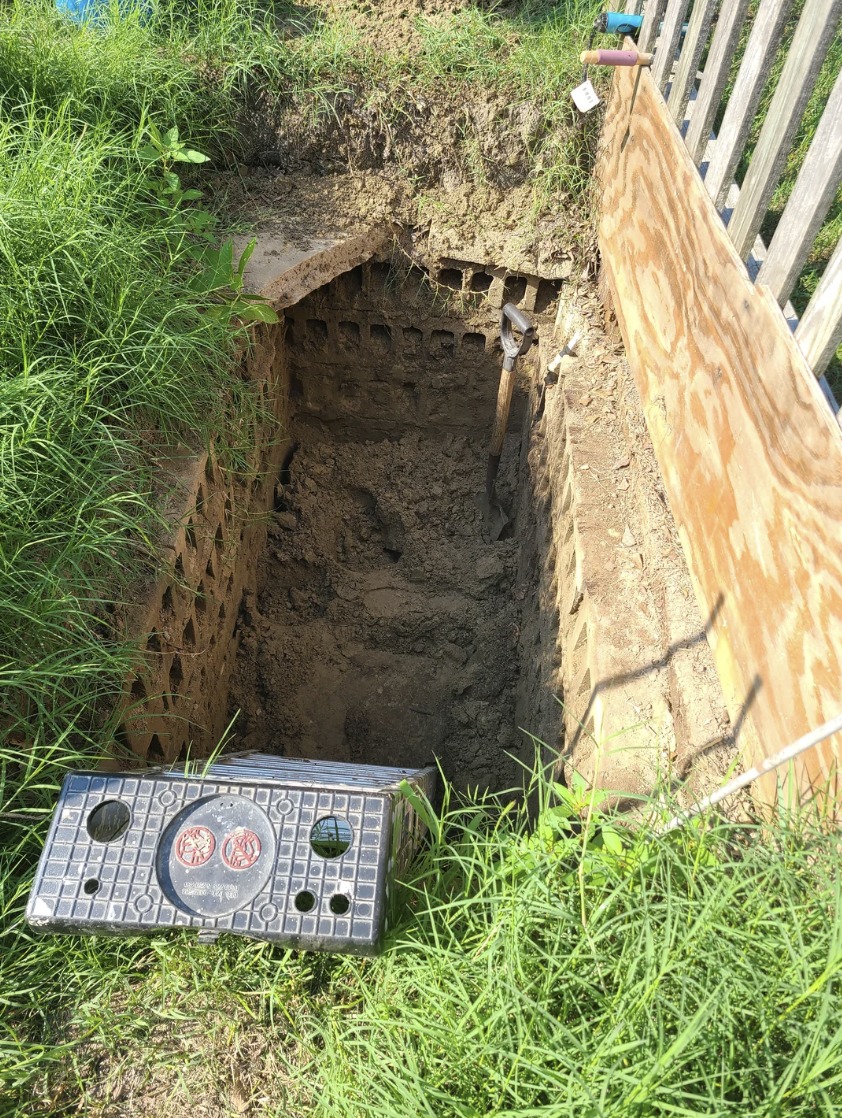It started out like any ordinary weekend in the backyard. I had planned to plant some marigolds or maybe finally set up the birdbath that had been collecting dust in the garage. But as I walked across the yard, something unusual caught my eye—a perfectly square indentation in the far corner that hadn’t been there before, or at least one I hadn’t noticed.

Naturally curious, I knelt down and started brushing away dirt. What I uncovered wasn’t a lost toy, a rock, or some buried trash—it was something solid, something man-made. As I dug deeper, I found that the top was covered with concrete slabs, which were oddly wired together using chicken wire. That alone was peculiar. It didn’t take long before I realized that I might have discovered a hidden cistern buried in my backyard. The hole was no minor feature either. It was five courses of concrete blocks deep, with the first layer starting about a foot below the surface. Measuring around 36 inches wide and 72 inches long, this wasn’t something slapped together for a weekend project.
My first thought was maybe it had been an outhouse pit, but it was way too large and precisely constructed to fit that idea. As I stared into this mystery, my mind flashed back to the stories my grandmother used to tell me about growing up on a farm. She had lived in a world without running water, where families relied on rain barrels and hand-dug wells to survive. In that moment, standing over this strange pit, all her stories came alive. The past suddenly felt very present, and I began to see that this wasn’t just a random hole—it was something meaningful. I started considering what the structure might have been used for.
A few possibilities came to mind. Most likely, it was a cistern or some sort of water storage tank. People in the early 1900s, when my house was built, often collected rainwater if their wells were inconsistent or hard to access. The depth and layout of this pit definitely lined up with that purpose. It could’ve been a septic tank, I thought, but that seemed less likely. It was too carefully crafted and too clean to serve that function. Maybe it was a root cellar or a storage pit, but it lacked the ventilation and depth for proper food preservation. Another thought was a dry well, but again, the design didn’t look like something meant for drainage. Everything about it suggested it was meant to store something valuable—most likely water. Learning that my home dated back to the early 20th century helped things click into place. Indoor plumbing wasn’t part of the original build, so the people who lived there had to improvise.
They used every bit of their land with purpose and intention. Standing over that pit, I could almost see the hard work that went into building the home and surviving day to day. There were no luxuries—just practical solutions to real-life needs. That pit, once an essential part of someone’s daily routine, reminded me that the ground beneath our feet holds more than dirt. It holds stories. Someone had once taken the time to dig that hole, lay those blocks, and cover it with slabs. Not for beauty or convenience, but for function—for survival. We often forget that the homes we live in today were once someone else’s everything. Someone cooked there, fetched water, raised children, and built a life. The next time you dig into your yard and hit something unexpected—a root, a rock, or even an old foundation—take a second and think. You might have found more than just debris. You might have uncovered a clue to the past, a piece of history that once mattered deeply to someone. That small pit in my backyard gave me more than just a mystery to solve. It offered a connection to the people who came before me and a reminder that even the most ordinary ground can hold extraordinary meaning. And in today’s world, that kind of perspective is a treasure all its own.




